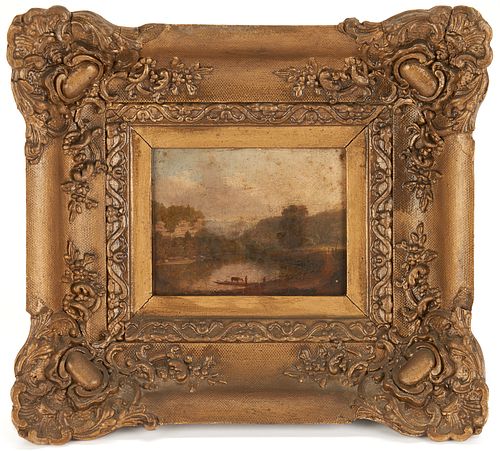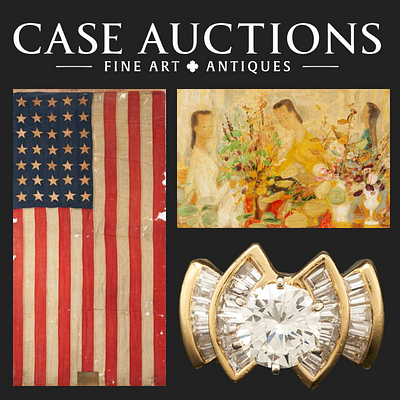Thos. Worthington Whittredge 1846 Oil Painting, Shaker Ferry - Kentucky River
About Seller
4310 Papermill Dr. NW
Knoxville, TN 37909
United States
Case Auctions is based in Knoxville, Tennessee, where our gallery is located, with satellite offices in Nashville, Tennessee and Kingsport, TN – but our reach is worldwide. Established in 2005, we conduct cataloged auctions of investment-quality art and antiques under the stewardship of knowledgeabl...Read more
Two ways to bid:
- Leave a max absentee bid and the platform will bid on your behalf up to your maximum bid during the live auction.
- Bid live during the auction and your bids will be submitted real-time to the auctioneer.
Bid Increments
| Price | Bid Increment |
|---|---|
| $0 | $10 |
| $100 | $25 |
| $500 | $50 |
| $1,000 | $100 |
| $3,000 | $200 |
| $5,000 | $500 |
| $10,000 | $1,000 |
| $20,000 | $2,000 |
| $50,000 | $5,000 |
| $100,000 | $10,000 |
About Auction
Jul 8, 2023
We invite you to participate in our Two-Day Summer Auction on Saturday, July 8th, 2023 at 9 AM EST and Sunday, July 9th at 1 PM EST. This auction will take place at our Knoxville gallery. Please click here to learn more about our auction and register to bid. Case Auctions bid@caseantiques.com
- Lot Description
Early miniature landscape view of Pleasant Hill, KY, by Thomas Worthington Whittredge (New Jersey/New York/Ohio, 1820-1910). The oil on paper laid on board painting, titled "Shaker Ferry- View on Kentucky River," depicts a landscape with a small ferry boat containing a figure and donkey moored on the river bank. A dirt path runs along the right shoreline and two toll road operators man an erect, pole-like boom barrier or boom gate at center right. Behind them, smoke rises from the chimney of a small house. On the opposite side of the river a waterfall flows from a rocky cliff. The view portrayed is of the historical ferry at Shaker Landing, located near the Shaker Village of Pleasant Hill in Harrodsburg, KY, along the Kentucky River. Titled, signed, and dated "1846" en verso. Housed in an ornate gilt and gesso frame with cartouche corner decoration. Sight: 3 1/4" H x 4 1/4" W. Framed: 9 1/2" H x 10 1/4" W. Note: This painting is among the earliest extant, dated works by Whittredge. It was likely painted during the self-taught artist's formative years as a painter while living in Cincinnati, OH from 1837-1843, or during his period in Charleston, WV, c. 1843-1849, before traveling abroad. A nearly identical signature appears in Whittredge's 1849 sketchbook in the collection of the Smithsonian Archives of American Art. (See Worthington Whittredge; Worthington Whittredge sketchbook of a trip down the Rhine River, 1849; Worthington Whittredge Papers, circa 1840s-1965; Archives of American Art, Smithsonian Institution) Biography: Born on a farm near Springfield, Ohio, Thomas Worthington Whittredge would later establish himself as one of the foremost painters of the Hudson River School. Growing up with little formal art education, Whittredge moved to Cincinnati at the age of 17 to work for his brother-in-law as a house and sign painter. He taught himself portrait and landscape painting and opened a daguerreotype studio in Charleston, West Virginia. However, his business failed, and he began focusing on landscape painting after 1843. In 1849, he was sponsored to travel to Europe where he enrolled in the Royal Academy in Dusseldorf, Germany, and traveled to Switzerland, Paris, and Rome where he studied naturalism and the Barbizon school. In 1855 he began to sign his work W. Whittredge, as opposed to his earlier signature of W. T. Whitridge or W. T. Whitredge. He returned to New York City in 1859 and began painting American landscapes in the Hudson River School style of New York and New England. In the 1860's he took a few trips west sketching oil landscapes of Western subjects, and traveled to Mexico with Frederic Church in 1896. He passed away in Summit, New Jersey in 1910. Today his work is represented in the Metropolitan Museum or Art (which the artist helped to develop), the Worcester Museum of Art, the Cincinnati Art Museum, and the Brooklyn Museum, among others. (Adapted from "Worthington Whittredge" by Esther T. Thyssen in AMERICAN PARADISE: THE WORLD OF THE HUDSON RIVER SCHOOL, ed. John O'Neil, New York: Metropolitan Museum of Art, 1987) About Shaker Landing: "The Pleasant Hill Shakers began acquiring land for river access as early as 1813, when they purchased Fulkerson’s Ferry a few miles downriver. By 1843 the Shakers had amassed an additional 200 acres of land on both sides of the Kentucky River. At its peak, Shaker Landing spanned from Brooklyn to the mouth of the Dix River, about a mile upstream. Along this site the Shakers built 13 structures, including a dwelling, warehouses and a stable. Shaker Landing served as the launch point for Shaker trade deacons for almost 50 years. The river connected the Shakers to markets as far south as New Orleans, where they would sell their goods and return with precious cargo such as sugar and coffee. Shorter trade routes were more common, with Louisville and Cincinnati as the most visited destinations. For nearly 100 years, the Shakers operated a ferry that would shuttle travelers across the Kentucky River for a small toll. Due to the construction of High Bridge and the increase of railroad travel, operation of the Shaker Ferry ceased in the late 1890s.The Pleasant Hill Shakers sold their ferry, and Shaker Landing, in 1909. Non-Shakers continued to run the ferry as a tourist attraction under its original namesake until 1940." (Source: Billy Rankin, "Landing in the Right Place," Shaker Village at Pleasant Hill website).No retouching visible under UV light. Craquelure and grime throughout. Top coating of grime has been lightly professionally removed. It is recommended that the buyer consult a specialist of oil on paper on board paintings for further cleaning.
Condition
- Shipping Info
-
Buyer pays shipping and is responsible for making arrangements through our recommended shippers or an outside shipper of your choice. For pre-auction estimates, provide the lot number(s) to the recommended shipper(s) of your choice:
The UPS Store of Bearden Contact - Joe 865-584-0081 (press 5), fax 865-584-0094 store2630@theupsstore.com
The UPS Store of Northshore Contact - Eve 865-951-2499 store6461@theupsstore.com
John & Max Express LLC NOTE: white glove delivery for furniture, fine art, and freight items (driving range limitations may apply, US only) Contact - Yev or Nadiya 865-230-1567 johnmaxexpress@gmail.com
Package Manager (UPS, FedEx, USPS, & DHL) NOTE: Crate and large freight services are also offered Contact - Burak 865-584-3000 Info@packagemanager.net
-
- Payment & Auction Policies
-
Available payment options
Payment must be received no later than five (5) days after the sale.
If paying with a credit card, a 3.5% credit card processing fee will be applied to the final sales price (i.e. hammer price + buyer's premium + applicable taxes). If you have a credit card on file with Case, any winning bids will be automatically charged (up to $3000) along with applicable fees 72 hours after you receive your invoice unless other arrangements have been made.
If paying with wire transfer, please use the following information:
Bank: Pinnacle Bank
150 Third Avenue South, Suite 900
Nashville, TN 37201
Phone # (865) 766-3000
Swift Code: PNFPUS44
Routing, Transit, ABA: 064008637
Beneficiary: Case Antiques, Inc.
4310 Papermill Drive
Knoxville, TN 37909
Account #: NOT DISCLOSED (please refer to your invoice email for the Deposit Account Number or contact us )
-
-
- Buyer's Premium



 EUR
EUR CAD
CAD AUD
AUD GBP
GBP MXN
MXN HKD
HKD CNY
CNY MYR
MYR SEK
SEK SGD
SGD CHF
CHF THB
THB
































